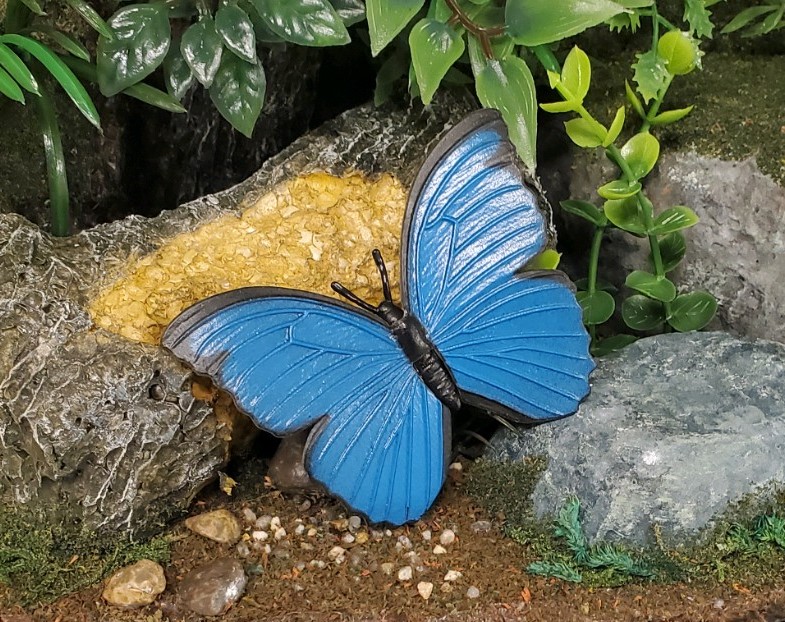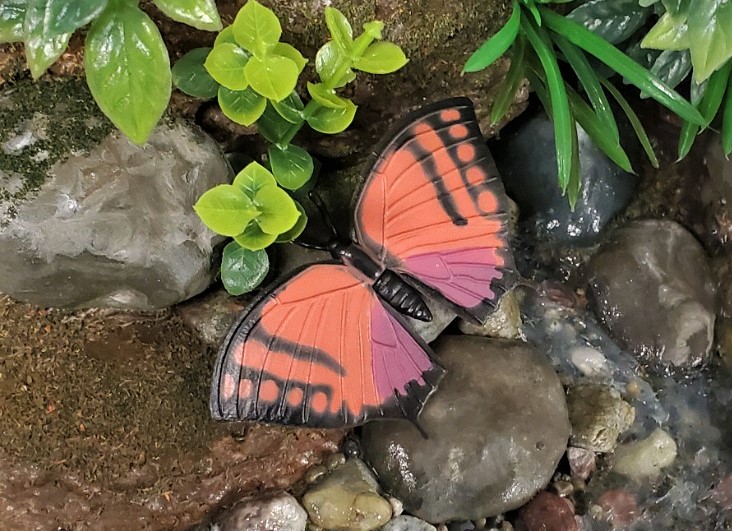Today I will be reviewing a collection of butterflies by Innovative Kids. It is from their Junior Groovies collection, which is a lot like the familiar Groovy Tube Books collection, but for a younger audience (ages 3-6, or, in this case, 48-year-olds who collect toy insects). First of all, I should thank STS forum member Saarlooswolfhound for alerting me to this on Amazon. She has a few of these in her collection, and I have been drooling over them for a while now, so it was nice of her to direct me to where I could get my own! The collection comes with a book and six butterfly figures. Each of the six butterfly species are featured in the book to introduce the reader to a specific biological concept related to butterflies (I’ll mention each below). Each species is marked on the underside with its common English name and the letter ‘K’ indicative of all IK products. Of the six species, two are completely new to me in toy form, and one is a first as an adult. Five of the six species are in the family Nymphalidae, so I might as well get my usual ‘they have too many legs for a member of Nymphalidae’ disclaimer out of the way now, but I am so excited for this set and two new species, I don’t really care about this common anatomical error. The figures are painted realistically both dorsally and ventrally, albeit sometimes stylized (especially on the venter). Species will be shown in order they appear in the book.

First up, the common morpho (Morpho peleides), a species endemic to the rainforests of Central and South America. The figure is stamped ‘blue morpho’ which could represent several species, usually M. peleides or M. menelaus. However, the illustrations in the book point to an ID of M. peleides. The book uses the morpho to introduce the reader to the life cycle of a butterfly. The figure has a wingspan of 6.8 cm, which puts at a scale of just under 1:1 to nearly 1:3.

Next up is the eastern tiger swallowtail (Papilio glaucus). This species is native to eastern North America. The book uses the tiger swallowtail to introduce the reader to the feeding habits of butterflies (e.g., using their proboscis to take nectar from flowers). The figure has a wingspan of 6.0 cm for a scale of 1:1.3-1:2.3.

Next up is one of the new/unique species (to the best of my knowledge), the noble leafwing (Fountainea nobilis). Leafwing butterflies have the undersides of their wings colored to look like dead leaves, allowing them to blend in with foliage or litter on the forest floor, and the book uses this species to introduce the concept of camouflage to the reader. The noble leafwing is endemic to Central and northern South America. The figure has a wingspan of 7.0 cm, which puts it about at the low end of a 1:1 scale (the wings are not spread fully, so the scale is an estimate).

The fourth figure is the other new/unique species, the silky owl (Taenaris catops). The silky owl is endemic to New Guinea and surrounding islands. The silky owl has large eyespots on its hindwings to distract (or possibly scare off) would-be predators. The book uses introduces this concept to the reader, together with the previous discussion on the noble leafwing, to broadly discuss butterfly defense mechanisms. The figure has a wingspan of 6.7 cm for a scale of 1:1.1-1:1.4.

Next up is the most commonly made species of butterfly, the monarch (Danaus plexippus). The monarch is distributed in North, Central, and South America, the Caribbean, the Azores, Canary Islands, North Africa, Australia, the Philippines, and South Pacific islands, with rare strays to the United Kingdom. The book uses the monarch to introduce the reader to two concepts. One is butterfly migration, for which the monarch is famous for. The other is to talk about how the butterfly’s bright colors alert would-be predators that it is poisonous and distasteful due to toxins acquired when the larvae feed on milkweeds.

The last species is the zebra longwing (Heliconius charithonia), a Neotropical species distributed from the southern United States to South America. This is my first adult of this species; I also have a caterpillar made by Club Earth. The book uses the zebra longwing to discuss roosting behavior, whereby some butterflies congregate in large groups at night and hang from trees to sleep. I suppose the book placed this at the end under the assumption the book would be good bedtime reading, and what better way to put a child to sleep then to finish of the book with the telling of how butterflies go to sleep.

Overall this is a great educational product for those of you with young kids. And hey, you can get some cool insect species for your collection at the same time! I recently bought mine on Amazon, and there were others available (saw at least one on eBay as well). It came out in 2016 and shouldn’t be hard to get.

Disclaimer: links to Ebay and Amazon on the AnimalToyBlog are affiliate links, so we make a small commission if you use them. Thanks for supporting us!



